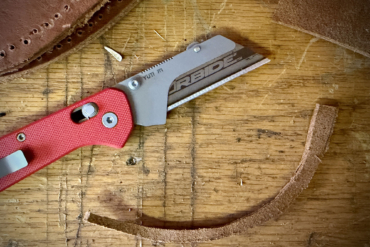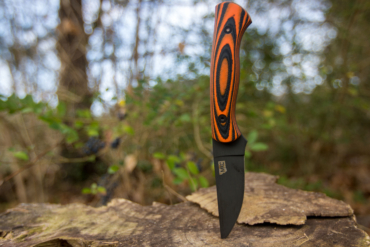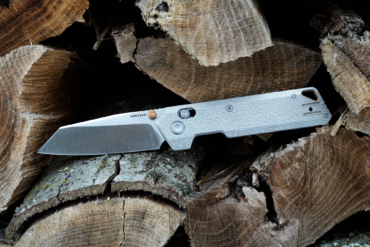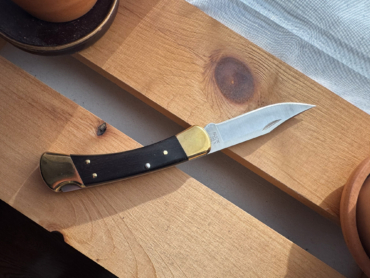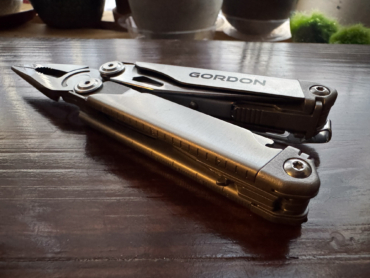Origin Handcrafted is pushing to launch a knife unlike any other. In hopes this Kickstarter reaches its goal, we put its Utility Knife to the grindstone to see how it performs.
Let’s cut to the chase, as this is a limited-time thing — the Origin Handcrafted Utility Knife is a beautiful kitchen tool. The brainchild of creators Marc Liss and Kayla Penelton, it’s the smaller companion to the large Santoku-style blade currently being championed on the company’s Kickstarter.
We covered this duo in a news piece a while back, and now I’ve had the chance to test one. Among the knife’s callouts is the blade forged from antique sawmill blades, some of which may have shaped the local Manitoba maple and oak whiskey barrels that make up the knife’s handle.
As of now, Origin’s Kickstarter is set to wrap up on June 30, 2022. The company has a history of meeting its goals, and this one is nearing the finish line.
So, if you want to get in on one of the most unique kitchen implements we’ve seen in some time, pick a link and get to pledging. And if you need a bit of convincing, check out the writeup and photos below.
In short: The Origin Handcrafted Utility Knife is a marvel of recycling, artful design, and skillful execution. If you’re looking for a set of kitchen blades with a unique combo of capability and soul, check out the company’s Kickstarter.
Origin Handcrafted Utility Knife Review

The Blade
Whether intentional or not, the paper that Origin used to wrap the review sample provided an immediate opportunity for edge testing. And this Utility came sharp, so much so that I felt compelled to emphasize it in italics.

But you don’t make a meal by slicing paper. So, to celebrate its first night in my kitchen, I dove into a full prep for enchiladas.
The Origin’s 5.12-inch (13cm) blade made easy work of onions, carrots, parsnips, and a whole mess of peppers, both fresh and dried.

As I worked, the knife also quieted the one concern I’d had out of the box: the width of its spine. As you can see above, the Utility Knife is just as broad across the shoulders as my full-size WÜSTHOF Pro Chef’s Knife.
A wide spine is great for strength, but it generally translates into less glide and more push when slicing. But at just over 1¼ inches tall (3.2cm), the Origin was largely able to overcome this issue.
And while the flat of the blade may not be quite wide enough to smash cloves of garlic, that’s not really what the Utility is designed for. That’s a full-size job better saved for the Santoku.
The Handle

While your eye may be drawn to blade specs and details, a good handle is no less important to a knife’s overall kitchen performance. Thankfully, Origin has included a good one.
Measuring 5.5 inches long (14cm), its octagonal geometry fits rather naturally into the palm. The wood combo, according to Origin, is “vacuum stabilized with resin, with the resin in the maple being dyed for contrast. The resulting handle is durable, comfortable, and eco-conscious.”
And after a few sessions of cutting, I’d tend to agree. The shape flares out toward a flattened end, providing more than enough real estate for hands both large and small.
Design, Durability

Let’s talk briefly about the logo. As attractive as it is, I did notice that water tended to pool within its letters. I also wonder about the various pits and holes in the upper portion of the blade.
In practice, these seemed to keep food from sticking as you cut. But they also provide additional nooks and crannies for moisture. When you clean your Origin, I’d pay special attention to drying out these spots. This is high-carbon steel, after all.

And speaking of which, this knife will patina. Almost immediately, in fact, when faced with acidic foods like onions, garlic, and limes. But that’s part of the charm, isn’t it? If you’re paying for a knife made from materials that have already lived a brave life, a few more marks only add to the charm.
Origin’s stated mission is to create tools that last. And after a week in its company, I see no reason why (if properly cared for) this knife should be anything but enduring.
Pricing & Conclusion
As mentioned, Origin makes its home in Canada, so there’s some currency conversion to be done. Pledges start at around $32 U.S., but that level will only net you a T-shirt. The Utility Knife can be had for a pledge of $210, and the larger Santoku requires a kick-in of at least $229.
Or, bundle both together for slots around $396.
These prices vary a little bit, depending on the timing of your pledge. And with many incredible kitchen knives available for less than $200, this may at first seem a little steep. But honestly, I can see the appeal.

Why? Because beyond the capabilities listed above, the Utility Knife (and its big brother, I’m assuming) offer more than a route to supper. Beyond its proven design, the materials and craftsmanship on display here are truly next-level.
Origin’s motivation — its passion for reclaiming pieces of its heritage and bring it into our kitchens — that’s almost as delicious as a full plate of enchiladas.
Learn more about news of the campaign, or head over to Origin’s Kickstarter for a chance to get in on the action.


